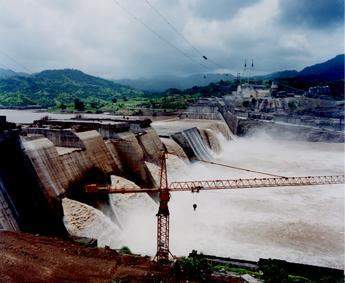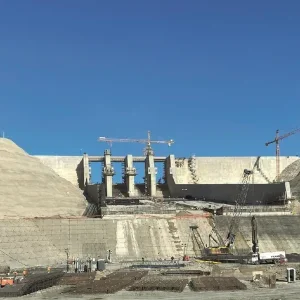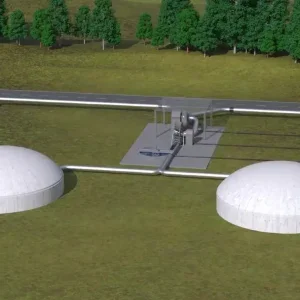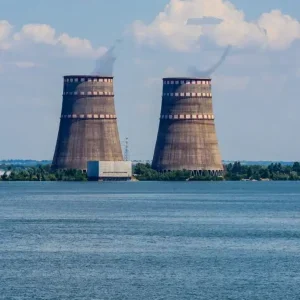
THINGS appear to be looking up for hydro finance in India. The Power Finance Corporation (PFC), India’s leading financial institution in the sector, has proposed the establishment of an India Power Fund (IPF) as an additional source of equity funding for power projects.
For the first time, the Washington, US-based International Finance Corporation (IFC), a World Bank affiliate, is reported to be taking up 10% equity in an Indian IPP hydro project. And the federal-owned National Hydroelectric Power Corporation (NHPC) has this year tapped a non-traditional source; insurance funds. To add to the US$552M loan that it had already signed up with the Life Insurance Corporation of India, NHPC is negotiating a further US$1.4B of credit, to be drawn over 20 years at a likely 6–6.5% interest rate.
Financing hydro projects in India has not been an easy process, particularly in recent years. It has become even more difficult considering the ambitious plans that India has drawn up to expand its power sector in the immediate future.
Under the slogan ‘Power For All by 2012’, the federal government wants to double its present installed generation capacity from all sources by adding 100,000MW by the year 2012 (with matching investments in transmission and distribution). The plan for expansion of the hydro power sector (which currently has a capacity of around 26,000MW) is even more ambitious. Under an initiative formally launched by the Indian prime minister in May 2003, the aim is to add an extra 50,000MW of hydro power capacity in 16 hydro-rich Indian states by the middle of the next decade. The necessary funds could amount to around US$66B.
Addressing the icold conference in Montreal, Canada on 20 June 2003, Mr R.V. Shahi, secretary of India’s ministry of power stated that this federal hydro power initiative had opened up ‘enormous opportunities’ for the national and international agencies, in the following manner: preparation of detailed project reports for the 162 identified new hydro projects, with over 50,000MW aggregate capacity; EPC contracts for the development of many of these projects; package-wise contracts in a large number of projects; investment opportunities as equity-holder and project developer; joint ventures with Indian companies for developing projects; providing finance opportunities for the funding agencies.
Difficulties
The funding of hydro projects in India has suffered due to a number of difficulties, many inherent in the sector itself, which dissuade an average financier to invest in them. These include:
• The long gestation of hydro projects in the country; anything from 5–10 years.
• Poor financial position of the state-owned power utilities. There is thus a low internal generation of funds, leading to excessive reliance on equity contribution by the government.
• Lack of financial security to the financier. An adequate set of security mechanisms which would be acceptable to the policy-makers, utility-owners and financiers has still to be finalised and put into effect.
• Slow progress in sectoral reforms and restructuring (see IWP&DC, September 2003, pp26–29).
• The small and undeveloped size of India’s capital market.
Equity
Since the Indian power sector privatisation of the early 1990s, certain concessions and incentives have been put in place by the government to encourage the entry of private power. The 1998 policy document on Hydro power Development in India stated: ‘A greater private investment through IPPs and joint ventures would be encouraged in the coming years and [the] required atmosphere, incentives and reliefs would be provided to stimulate and maintain a trend in this direction’.
However, the entry of IPPs in the large and medium hydro projects in India has been modest until now, and confined to a few domestic companies like Tatas, Jaypee Group and LNJ Bhilwara. Even in small hydro, where a rapid development has taken place in the last five years, it is the domestic IPPs that have taken the lead. Despite a flurry of memoranda of understanding signed with some state governments in the initial years of privatisation, overseas hydro companies did not translate those into actual projects. Such companies showed more interest in the sale of hydro equipment and in EPC contracts, as NHPC found out a few years back (while seeking private partnership for its new projects).
The absence of overseas equity in Indian hydro power has aggravated the already tight funding situation in the domestic capital markets. In the context of the rapid socio-economic development taking place in India, the size and structure of such capital markets remain comparatively underdeveloped. Hydro projects had not been considered as attractive investments by banks and financial institutions. The norms laid down by India’s Reserve Bank for them further restrict their exposure to any particular sector (like power) and to any individual company seeking funds from a bank or financial institution.
This has led to project promoters trying out various innovations. While IFC has been persuaded to take a small equity in an Indian hydro project, Mumbai-based BSES, a vertically-integrated power company, has recently converted some of its global depository receipts into equity in the company.
In the matter of obtaining equity funds, the hydro projects developed by federal-owned companies in India had been better placed. They had traditionally been receiving funds under the annual federal Budgets. The position became even better after 1998, when the hydro power policy assured funds (including equity) to the federal generators, both for the ongoing and selected new projects, so as to ensure achievement of targeted additions to the installed capacity. It is no wonder that most of the current and proposed action in Indian hydro power is by federal-owned generators like the NHPC.
The federal budget has proposed the creation of an ‘infrastructure equity fund’ with an initial corpus of about US$22M. However, in view of competing demand from other basic sectors (like roads, ports and airports), the power sector could well end up getting only a small share of this fund.
PFC’s proposed IPF may begin with a corpus of US$110M and go up to US$1.1B. It could be subscribed by power companies, banks and financial institutions, domestic, overseas and multilateral. The ministry of power has suggested contributions to IPF to be made fully tax-deductible. If the Indian government agrees to its creation, the proposed fund could mark a big step towards easing the power-equity situation.
Debt-financing
The developers of hydro projects in India, like other power promoters, have relied on a variety of sources to seek debt funds. An important source has been the three specialised financial institutions set up and wholly owned by the federal government to provide power finance. The various sources include:
Power Finance Corporation (PFC)
PFC was established by the federal government in 1986 and it began its operations in 1988. Since then, it has given loans to various types of power projects, including US$260M to hydro. Some US$238M has gone to new projects while the rest has been spent on the uprating and refurbishment of old hydro stations.
Most of PFC’s project loans have gone to state power utilities which, through unsatisfactory balance sheets, have found it difficult to tap the traditional sources of project finance. PFC has been particularly helpful in uprating and refurbishment projects, in which it has sat with the owner utility to work out plans, shortlist consultants, prepare project reports, cover the bulk of the project cost through loans and monitor progress.
Other federal financial institutions
Two other federal-owned financial institutions operate in the domestic power sector; the Rural Electrification Corporation (REC) and the India Renewable Energy Development Agency (IREDA).
REC was set up to fund rural power schemes. However, in November 1999, the federal government directed it to also fund small hydro projects below 25MW.
Small hydro financing has, nevertheless, been a preserve of IREDA. Between the years 1987-2002, it loaned around US$275M to small hydro projects throughout the country, and disbursed about 40% of the loans sanctioned by it during that period.
Supplier credit
Manufacturing facilities have already been set up for big and small hydro machinery, both by domestic suppliers like BHEL and overseas companies like alstom and ABB. Either as a part of the tender terms or otherwise, potential suppliers offer or propose to arrange credits to fund a hydro project. NHPC’s 400MW Uri project, built by a Swedish-UK consortium, was funded largely by the financial package put together by the latter.
Public financial institutions
Several large Indian public financial institutions like IDBI, IFCI and ICICI began to show interest in the last decade after power was privatised. A new player is Infrastructure Development Finance Co., set up in the 1990s specifically for infrastructure funding.
Domestic banks / commercial lending
Since privatisation, domestic banks have been an important source of funding for power loans and small hydro projects.
The giant 1420MW Sardar Sarovar project comprising irrigation, power and drinking water components, is being funded largely through bonds, after the World Bank decided to withdraw from it. Commercial borrowing, both domestic and overseas, is also used by power financial institutions to raise funds through bonds and straight loans.
Multilateral agencies
Institutions like the World Bank and Manila, Philippines-based Asian Development Bank (ADB) could be supplemental sources of funds, particularly to help hydro projects to achieve financial closure. In the 1980s and 1990s, the World Bank lent US$156M to the Upper Indravati, Orissa state; US$230M to the 1000MW Koyna-IV, Maharashtra; and US$447M to the 1500MW Nathpa Jhakri, Himachal.
The Bank also gave two lines of credit, totalling US$180M to IREDA for on-lending to private small-hydro projects. However, lately both the World Bank and ADB have concentrated more on funding power restructuring and reforms in India, and also programmes to improve power efficiency.
Export credit agencies / bilateral credits
Export credit agencies (ECAs) are another potential source of hydro credit. In the 1990s, Hermes of Germany, gave a guarantee to a US$220M loan from BV Bank to the 400MW Maheshwar project. The preceding two decades were also the era of big hydro-funding under bilateral credits arranged at government level. The best example was the 1000MW Tehri Stage-I project, started through part-financing by the erstwhile USSR.
NHPC received French credit for the 390MW Dulhasti project, Canadian aid for the 300MW Chamera-II, and Japanese aid (through OECF, now JBIC) for the 280MW Dhauliganga scheme. Among the other major hydro projects, OECF also funded the 900MW Srisailam Left-Bank project of Andhra Pradesh SEB, the 1450MW Sardar Sarovar project of the state-owned SSNNL and the 900MW Purulia pumped storage plant of West Bengal SEB.
Foreign banks / financial markets
Overseas commercial borrowing by Indian hydro developers is becoming increasingly common. With more and more hydro projects being taken up in the country, the demand for funds is high. India is also much more favourably viewed now as an investment area. The EPC contractors are arranging to obtain overseas credit. Big hydro promoters, both in the public and private sectors, are also directly able to approach and get the nod from overseas funding agencies for bankable projects. For Teesta-V, NHPC secured a US$250M loan from Deutsche Bank. It has recently been looking for another loan of the same amount for the 520MW Onkareshwar scheme (and another US$100M to recoup earlier high interest loans).
The Indian Government set up a high-level panel in August 2003 to study and suggest steps to attract more investment. The terms of reference include: analysis of the existing investment climate in the power sector; suggesting measures for promoting and facilitating private investments, both domestic and overseas; suggesting an enabling fiscal regime for securing such investments; and recommending an electricity tariff policy.
The Panel was requested to give its report by the end-2003.
Action for the future
The following steps could be taken to ease the funding of the Indian hydroelectric sector:
• Sectoral reforms and restructuring need to be expedited.
• To make the government-owned power utilities more financially viable, various steps have to be quickly completed. These include the securing of SEB’s old debts by issue of bonds, change in depreciation norms for hydro projects and concessions in taxes on power project and equipment.
• A suitable ‘development surcharge’ per kWh of power generated (or distributed), as proposed in the federal Hydropower Policy of August 1998, needs to be imposed to supplement funds for the hydel sector.
• The IPF should be quickly established.
• A mutually agreed and acceptable set of security mechanisms, as the cover for power-debts, has to be finalised.
• Fund-raising by PFC, REC and IREDA has to be made cheaper.
• To tap overseas markets, a greater resort to depository receipts by the power sector is required.
• Innovative methods of financing have to be put in place, like long-term debt instruments, take-out financing and joint ventures.
Related Articles
India to invest heavily in hydro
Spotlight on… finance
Tables
Table 1






